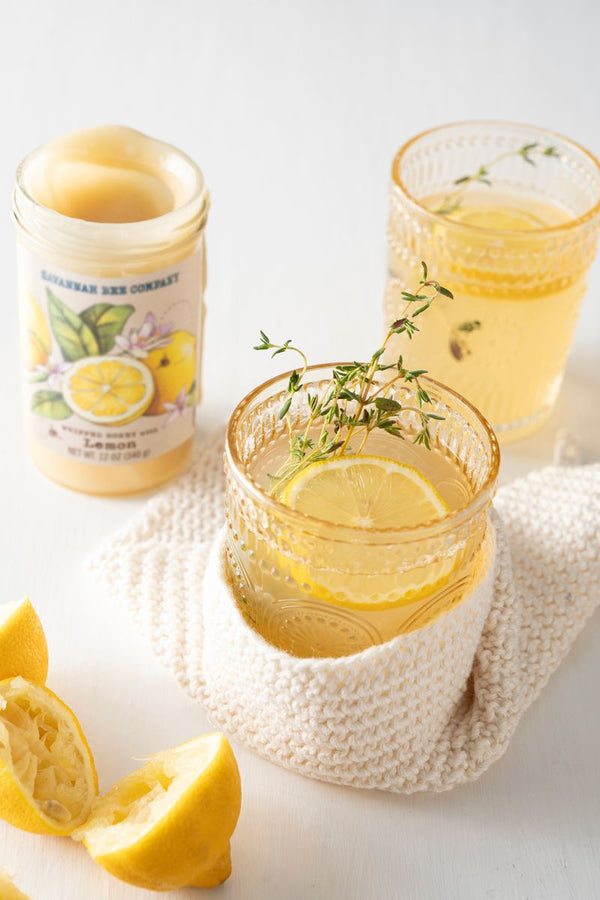What is Honey Crystallization — and Why Does it Happen?
You may be tempted to toss that jar of honey you found in the back of the cabinet.
It looks cloudy, crusty, and flaky — it must have gone bad, right?
Actually, it hasn’t! It’s just crystallizing, a natural process that almost every honey, especially pure honey, goes through.
It happens when the honey’s glucose separates from the water and stabilizes, turning into crystals.
Crystallization, A.K.A. granulation, is totally normal.
In fact, properly stored honey can remain good to eat for decades, even centuries.
Honey's sugar content and low pH make it impossible for the organisms that spoil food to survive.
This bee magic keeps your honey safe to enjoy for pretty much forever — even when it’s crystallized.
Let’s talk science!
Honey is a highly concentrated sugar solution, which means that the water in the honey contains more sugar than it naturally should.
That unstable solution is what gives us the sticky, viscous texture we all love.
The sugar in honey, specifically glucose sugars, want to become stable. Over time it will granulate to achieve that stability, forming that crystalline texture.
Because these newly formed crystals are denser than the remaining honey, they tend to collect at the bottom of the bottle.
As more and more glucose crystallizes, honey changes from that unstable saturated solution to a more stable saturated form — the thick and grainy honey you found at the back of your cabinet.
But be warned: not all crystallization looks the sam
Some honeys crystallize completely, while some only partially crystallize.
The size of the crystals can also vary from honey to honey.
Some form fine crystals that make a nice, smooth, and creamy spread. Other honeys develop large, jagged crystals that result in a thick, flaky texture.
Despite it’s change in appearance, that is still the same delicious honey you know and love - just a different texture!
You may still be suspicious, and that’s totally fine.
But odds are you’ve eaten crystallized honey before - especially if you shop with Savannah Bee Company.
Our delicious Whipped Honey? Crystallized.
That’s right — we intentionally encourage these honeys to granulate rapidly in a controlled environment so they develop into the smooth, creamy sweetness you just can't get enough of.
What Causes Crystallization?
Temperature, temperature, temperature!
Temperature is one of the biggest factors that affect crystallization.
Crystallization happens faster in lower temperatures.
To help prevent crystallization, it's best to store honey in a sealed container between 50 and 70 degrees Fahrenheit - roughly room temperature.
Once it gets below 50 degrees, it will tend to crystallize and become dense.
On the opposite end, freezing honey helps keep it from granulating.
In freezing temperatures, the honey becomes too cold for crystals to form.
Confusing, I know, but that’s chemistry for you. (A note about Whipped Honey storage: keep it on the counter if you like it soft and in the fridge if you like it a little thicker.)

Why don’t we like Crystallization?
The short answer is because it’s not familiar to us.
Those of us in the United States are used to grocery store honey, which is typically a mass-produced, pasteurized mixture of honey and various syrups.
This stuff doesn't crystallize. Why? Because that honey is highly processed, which destroys it’s nutrients and removes it’s pollen.
That being said, not all honey at the grocery store is "fake." There are some quality honeys out there, filled with the nutrients you need and the taste you love - you just have to do your homework.
There is a common reason why people consider crystallized honey to have “gone bad."
Raw honey has not been pasteurized and contains live yeast - a key ingredient in the fermentation process.
When crystallization begins, and glucose separates from the honey, the leftover water allows the yeast to grow and ferment the sugars.
Fermentation can make the honey smell and taste different, but that doesn’t make it bad or expired.
But leave it fermenting long enough, and you may have made your first small batch of mead.
How to De-crystallize Honey
If you notice your honey is starting to crystallize and you’d rather stop the natural process, there are some steps you can take to reverse crystallization.
The best, most common method is to fill a bowl with hot (not boiling) water and let your bottle of honey sit in it until the crystals dissolve.
Swirl the jar around occasionally to make sure the heat distributes evenly.
You can also microwave crystallized honey on a very low setting.
But know that high temperatures will destroy the enzymes and vitamins, and can change the color and flavor of your honey, so we don't recommend it!
How to use Crystallized Honey
If you’re willing to take a chance on your crystallized honey, there are a ton of ways to use it.
It makes a delicious addition to baked goods, or as a spread on hot biscuits or toast.
You can also add it to your tea and coffee — it will melt in seconds and taste just a great.
So don’t be afraid to use your crystallized honey, and by all means, don’t throw it out!
Crystallization is a natural process that tells you your honey is the good stuff.
And if you find yourself craving creamy, textured honey but don’t want to wait for yours to granulate, treat yourself to some Savannah Bee Whipped Honey!
#savethebees
Whipped Honey with Cinnamon
$28.00
$28.00
Published













